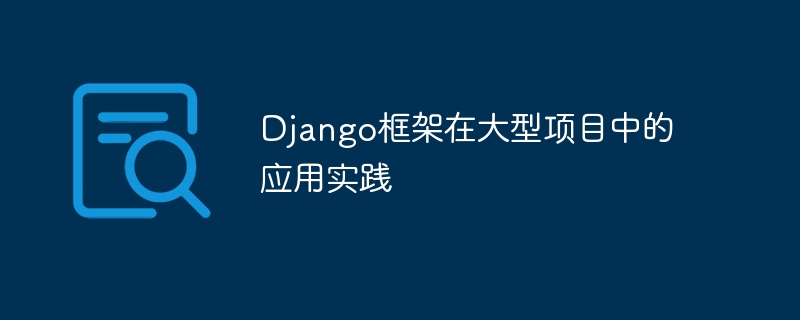Home >Backend Development >Python Tutorial >Application practice of Django framework in large projects
Application practice of Django framework in large projects
- WBOYWBOYWBOYWBOYWBOYWBOYWBOYWBOYWBOYWBOYWBOYWBOYWBOriginal
- 2024-01-19 10:27:151208browse

With the rapid development of web applications, many companies and organizations will choose Django as the framework for their web applications. The Django framework has powerful features, including: rapid development, reusability, security, flexibility, and scalability. This article will discuss the application practices of the Django framework in large projects and provide specific code examples.
- Advantages of Django Framework
The Django framework provides a set of tools to easily build high-quality and reusable web applications. Following are some advantages of Django framework:
a) Reusability: Django framework provides a kind of micro-application called Django app, which is ideal for building more powerful applications. Django applications are reusable and composable, making adding and removing applications from your project very convenient.
b) Rapid development: Web applications based on the Django framework can be developed in a short time. The Django framework provides many functions, such as automatically generating database models, templates, Form forms and Admin pages, etc., which allows developers to focus on business logic.
c) Security: The Django framework has built-in security mechanisms, such as built-in CSRF protection, XSS protection and Clickjacking protection. In addition, Django also provides some functions for developers to use, including password hashing functions and secure cookies.
d) Flexibility: The Django framework can adapt to many types of applications. For example, Django supports multiple database engines, including SQLite, MySQL, and PostgreSQL. In addition, Django also supports a variety of template engines and is very flexible in terms of front-end.
- How to apply the Django framework to large projects?
Although the Django framework is used for rapid development, it still needs to be optimized when it is applied to large projects. The following are best practices for applying the Django framework to large projects.
a) Use layered architecture: Layered architecture is an architecture that divides the code into several layers, such as model layer, view layer and form layer. This helps break down the code into small parts and divide the project into manageable and easily scalable units by using a strict MVC pattern.
Sample code:
#模型层
from django.db import models
class Author(models.Model):
name = models.CharField(max_length=100)
class Book(models.Model):
title = models.CharField(max_length=200)
author = models.ForeignKey(Author, on_delete=models.CASCADE)
#视图层
from django.views.generic import ListView
from .models import Book
class BookListView(ListView):
model = Book
template_name = 'book_list.html'
#表单层
from django import forms
from .models import Book
class BookForm(forms.ModelForm):
class Meta:
model = Book
fields = ['title', 'author']b) Optimize database access: In large projects, database access may become a bottleneck. Therefore, optimization is required, for example, using techniques such as template caching, query caching, and optimized queries.
Sample code:
#模板缓存
{% cache 500 "book_list" %}
<ul>
{% for book in book_list %}
<li>{{ book.title }} - {{ book.author.name }}</li>
{% endfor %}
</ul>
{% endcache %}
#查询缓存
from django.core.cache import cache
from .models import Book
def get_book_list():
key = 'book_list'
book_list = cache.get(key)
if book_list is None:
book_list = Book.objects.all()
cache.set(key, book_list, 300)
return book_list
#优化查询
from django.db.models import Count
from .models import Book, Author
author_list = Author.objects.annotate(book_count=Count('book')).order_by('-book_count')c) Using task queue: Task queue is an asynchronous processing mechanism that is widely used in large projects. Popular task queues in Django include Celery and Dramatiq, among others.
Sample code:
#Celery
from celery import Celery
from django.core.mail import send_mail
app = Celery('tasks', broker='amqp://guest@localhost//')
@app.task
def send_email_task():
send_mail('Subject', 'Body', 'from@example.com', ['to@example.com'])
#Dramatiq
import dramatiq
from django.core.mail import send_mail
@dramatiq.actor
def send_email_task():
send_mail('Subject', 'Body', 'from@example.com', ['to@example.com'])d) Perform code refactoring: Refactoring is a method of optimizing code to eliminate duplication in the code, reduce redundancy and improve maintainability. Django projects can be effectively refactored using appropriate design patterns and following the PEP 8 coding style guide.
Sample code:
#设计模式
from django.urls import reverse_lazy
from django.views.generic import CreateView
from .forms import BookForm
class BookCreateView(CreateView):
model = Book
form_class = BookForm
success_url = reverse_lazy('book_list')
template_name = 'book_form.html'
#PEP 8代码风格指南
from django.shortcuts import render
from django.http import HttpResponse
def my_view(request):
if request.method == 'GET':
return render(request, 'my_template.html')
elif request.method == 'POST':
return HttpResponse('Hello, World!')- Conclusion
The Django framework is widely used in large projects. This article provides some best practices and sample code, including using layered architecture, optimizing database access, using task queues, and code refactoring, to help developers effectively use the Django framework to build high-quality and maintainable web applications. .
The above is the detailed content of Application practice of Django framework in large projects. For more information, please follow other related articles on the PHP Chinese website!
Related articles
See more- How to avoid sql injection in django
- Application practice of efficient message communication processing based on Swoole
- Application practice of realizing multi-level caching through caching technology in PHP
- Application practice of PhpFastCache in big data processing
- Discussion on the scalability of PHP code testing function in large projects

